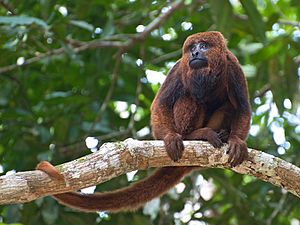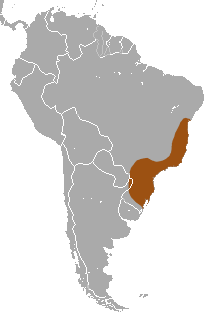Brown howler facts for kids
Quick facts for kids Brown howler |
|
|---|---|
 |
|
| Brown howler monkey in Minas Gerais | |
| Conservation status | |
| Scientific classification | |
| Genus: |
Alouatta
|
| Species: |
guariba
|
| Subspecies | |
|
Alouatta guariba clamitans |
|
 |
|
| Brown howler range | |
The brown howler (Alouatta guariba) is a type of howler monkey. These monkeys live in the forests of southeastern Brazil and northeastern Argentina. They usually live in small groups of 2 to 11 monkeys. Even though they are called "brown howlers," their fur can be reddish-orange or even black.
The brown howler has two main types, called subspecies:
- Northern brown howler (A. g. guariba) - This type is in serious danger of disappearing.
- Southern brown howler (A. g. clamitans)
Contents
Where Do Brown Howlers Live?
Brown howler monkeys live in the Atlantic Forest in South America. This forest stretches across several Brazilian states. It also reaches into the Misiones area of Argentina.
What Do Brown Howlers Eat?
Brown howler monkeys mostly eat leaves and fruits. They are known as folivores (leaf-eaters) and frugivores (fruit-eaters). Some of their favorite foods come from Ficus (fig), Zanthoxylum, and Eugenia trees.
Monkeys living in cooler places might eat fewer leaves. Young leaves are better for them than older, tougher ones. Their diet also includes ripe fruit, wild figs, flowers, seeds, and even moss. The Atlantic Forest is becoming broken up into smaller pieces. This is called forest fragmentation. Even with less habitat, brown howlers seem to find enough food.
How Do Brown Howlers Behave?
Why Do Howlers Howl?
Brown howler monkeys are famous for their loud howls or roars. They can make these sounds because of their special bodies. They have a large voice box (larynx) and a big chest. This helps their calls echo and become louder. They also have unique vocal cords.
Howling often happens to protect their mates. It is most common when both male and female howlers are together. Males usually start the howling. Females join in much less often. Howling can also happen during the dry season. This might be because food is harder to find. Howlers use their calls to show that an area or food belongs to them.
How Do Howlers Avoid Predators?
The black hawk-eagle hunts brown howler monkeys. The howlers' loud calls can actually help the eagles find them. When a brown howler sees an eagle, it does three things. First, it warns the group and then everyone becomes quiet. Next, they climb down into the lower parts of the trees. Finally, they spread out in an organized way. Adult monkeys lead the young away from danger. Young monkeys are the main target for the eagles. If there are no young monkeys, adults are less worried.
When land animals threaten them, brown howlers stay high in the trees. They remain silent for 5 to 15 minutes.
What is Rubbing Behavior?
Brown howler monkeys rub against each other to communicate. Males rub their throat bone (hyoid bone) and chest bone (sternum) together. This shows other males who is in charge or marks their territory. Males also rub females. Males rub more often than females, showing they are dominant. Dominant females rub more than other females, but still less than males.
How Do Brown Howlers Reproduce?
It is hard to study how brown howlers reproduce in zoos. So, we don't know everything about it. They can have babies all year round. It doesn't seem to matter if it's rainy or dry, or if there's more fruit or leaves. Because they eat a lot of leaves, mothers might not need perfect conditions to get pregnant.
On average, a mother brown howler waits about 19.9 months between babies. This is similar to other howler species. The sex of the baby or how many females are in the group doesn't change this much. If a baby dies, the mother will have another baby sooner. This is one of the few things that affects how long she waits.
Brown Howlers and Yellow Fever
Brown howlers can get very sick from the yellow fever virus. Many of them die if they get it. If many brown howlers are found dead, it can be a sign that yellow fever is spreading. Because so many monkeys die, they don't usually keep the virus in their population for long.
Some communities living near howlers used to think the monkeys caused the disease. They would kill them to stop it from spreading. To protect brown howlers, people should stop killing them. Also, people should get vaccinated to prevent the disease from spreading to themselves. Yellow fever is spread by mosquito bites. In South America, certain types of mosquitoes carry the virus.
In 2008-2009, there was a yellow fever outbreak among brown howlers. This happened in a protected park in Argentina. Brown howlers are not common in Argentina. So, any outbreak could really hurt their numbers. A group of scientists created the Brown Howler Conservation Group. They study and watch for yellow fever in howler populations.
See also
 In Spanish: Guariba para niños
In Spanish: Guariba para niños



